|
Miranda
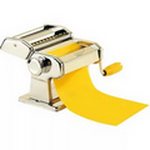 The inevitable result of communication on the culinary forum is the desire to acquire various kitchen devices, the existence of which had never existed before. Thanks to the forum, that only I have not appeared - from a simple yogurt maker I "matured" to a kitchen car, having bought a lot of interesting things along the way, including a noodle cutter. The inevitable result of communication on the culinary forum is the desire to acquire various kitchen devices, the existence of which had never existed before. Thanks to the forum, that only I have not appeared - from a simple yogurt maker I "matured" to a kitchen car, having bought a lot of interesting things along the way, including a noodle cutter.
I chose the noodle cutter according to the principle - I will buy the simplest mechanical one, I will like it or not, and according to the results, I will either buy myself a super cool one, or I will not feel sorry for the money. The only condition was - I want the length of the rollers to be as long as possible.
From the reviews, I knew that there are mainly noodle cutters on the market with a roller width of 14-15 cm, and 17-19 are not enough. Even wider - quite a rarity. It would seem, well, what is the extra 4 + -cm. For noodles - there is no difference, but if you roll the dough for dumplings, followed by using the dumplings, it is better to be wider.
By the way, some manufacturers and stores are cunning with the description of the width, indicating not the width of the rollers, but the width of the rollers + the width of the sides. Therefore, you can see both 21 and 22 cm. It is necessary to check.
So, since I didn't have many requirements, then my choice fell on the simplest complete set of Bekker BK-5200 noodle cutters, with the declared 18cm. the width of the rollers, and the price is slightly higher than 1 thousand rubles. Everything suited me and I bought it.
The box is bright, but simple, made of not very thick cardboard.
All information is indicated on the sides. And the box weighs about 3 kg. And the noodle cutter itself is complete - 2.8 kg.



One of the ends shows the dimensions and equipment

Everything inside is very, very modest.
But tight, and the stainless steel noodle cutter, there is nothing to break. Although, I still love it when there is a pimpled film, and not just a cardboard laid.
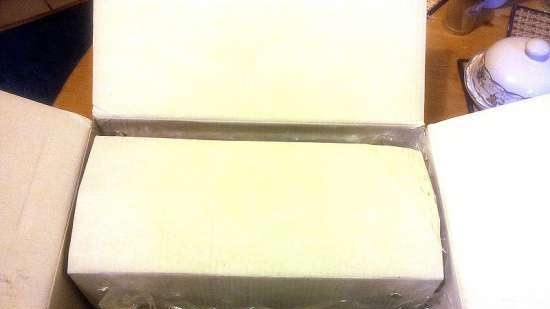

But at the bottom there was an instruction!
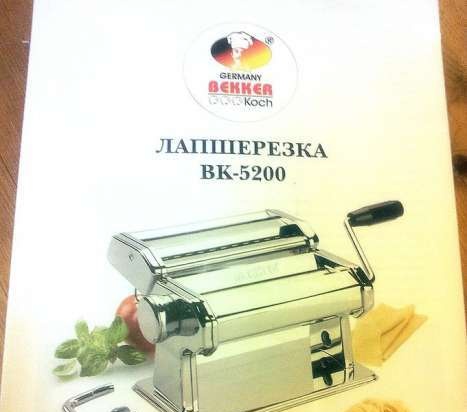
The instruction is printed in two languages - English and Russian. Each page has its own language.

Here, I took everything out of the box.
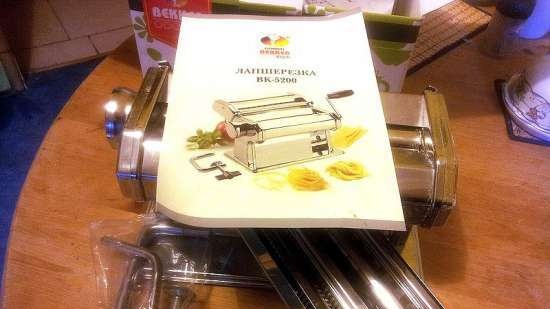
The noodle cutter consists of a rack with rollers for rolling out the dough and a removable block with two knives for thin noodles (if you skip the thick dough, it will be almost spaghetti) and for wide flat Fettuccini noodles. A handle to twist and a clamp to attach to the surface.
In the photo there is a removable block, a handle and a clamp.
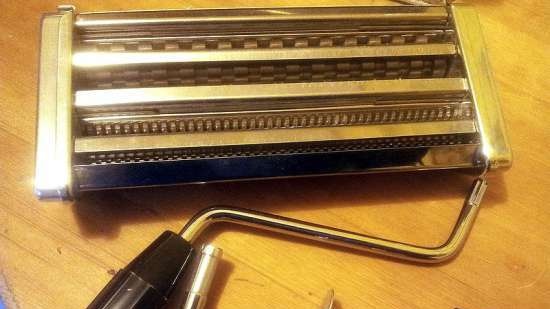
The length of the dough rolls is slightly less than 18cm.
Looking ahead, I can say that the dough is confidently rolled out to a width of at least 17 cm, or it can be rolled out to all 17.5 cm.

The stand with rollers is attached to the table.
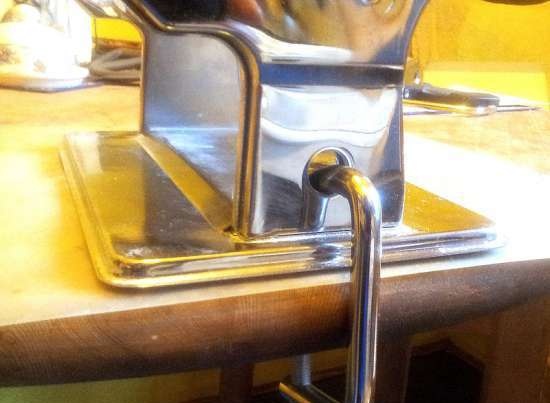
I put on the replaceable unit immediately, because even if I just need to roll out the dough, it serves as a stand. The block is inserted into the runners.

The handle is removable, and it must be rearranged into the nest whose rollers are used - rolling or one of two cutting knives.
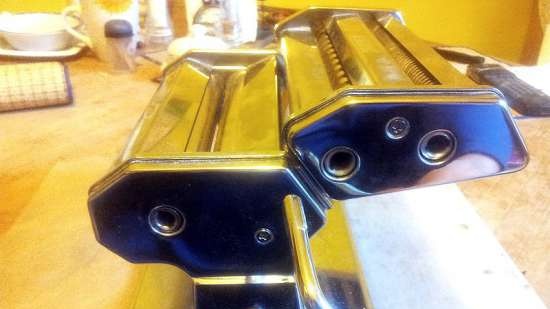
Well, the machine is all assembled, nothing complicated, you can get to work.
Don't forget to set the thickness control to 1 (red arrow).
In different noodle cutters, the count can go in different ways, but more often from 1 to 9. Although, it is the other way around - from 9 to 1.
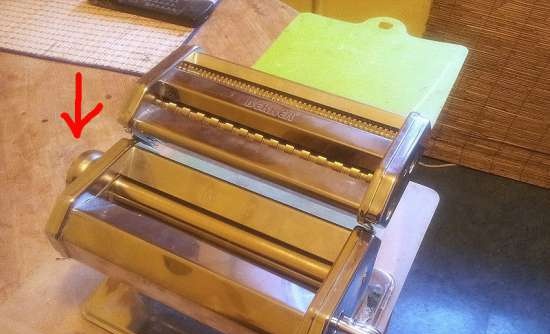
When you buy a noodle cutter, you can check it on paper in the store - pass the paper between the rollers with knives and see how it cuts, whether it has chewed, whether it has cut everything.
***
I made the dough in advance. Recipes for various doughs can be found on the forum.
Dumplings, dumplings, noodles (recipes)
I love this recipe
Dumplings dough without kneading in 21 seconds! (dough for dumplings with knives in a food processor) + video
But today I made another dough, completely from durum flour. Let's start rolling and cutting the noodles.
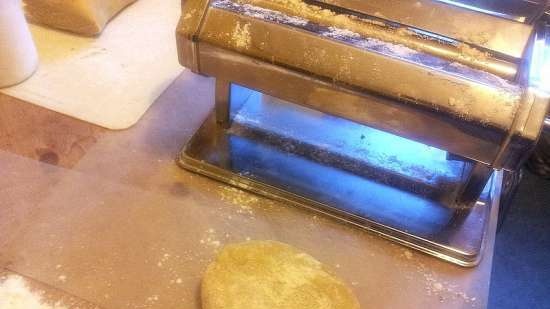
At the thickest thickness (here it is 1), we scroll the dough several times, folding it after each scroll and scrolling again.


Gradually moving to a more subtle one.
The round control knob for the thickness in most noodle cutters is arranged in the same way - you must first pull it slightly to the side (inside the spring, so that it does not switch itself), scroll to the next digit in the pulled position, and put it back in place.
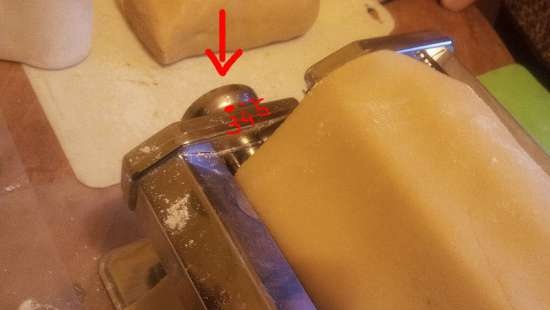
The dough becomes thinner and longer (rolls out).
And the knife block supports the dough.

When rolled out to the desired thickness, then rearrange the handle in the groove of one of the knives, and serve the dough. Depending on the dough, I sometimes let the rolled layer dry for 5 minutes so that the noodles do not stick together when cutting. Rather, I first roll out all the dough, and at this point the first layer is ready for cutting.
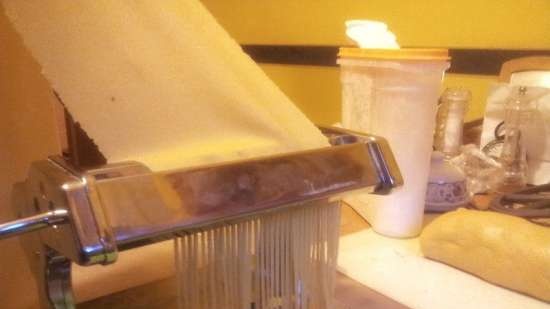
I rolled out the next piece of dough and cut it into wide noodles.
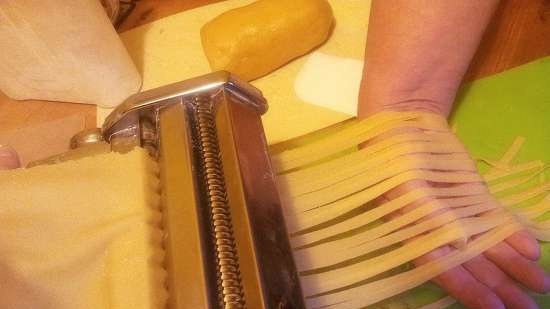
The noodle cutter is easy to assemble and easy to disassemble.
Under no circumstances can it be washed under water! Dry clean only with a brush or dry cloth. After all, some part of the flour remains, gets into the gears, and if water gets there, then the flour will harden like a stone and can break the mechanism. This applies to all noodle cutters - mechanical or electrical. No water!
***
In the end, I really liked the dough sheeter noodle cutter.
Noodles, dough for dumplings, dumplings, lasagna.
True, I still haven't bought a super cool electric one, well, this one will not wear out, although it will soon be two years old.
During this time, I made the following conclusions:
1. Dough sheeter noodle cutter is definitely needed in the house.
2. Mechanical or electrical - here already from the wallet. A mechanical one can be rolled out and cut at night, but with an electric one, one must take into account the level of noise and sleeping neighbors. But electric everything will be faster and hands free.
3. Super cool dough will cut even wet dough, but with cheap dough, depending on the dough recipe, it may take five minutes to dry.
4. The width of the rolling rollers is almost irrelevant, because even 17.5cm. when using the dumplings, it is still not enough, and I overlap or blind. Although, it's nice to have a wider layer of dough.
Well, since. I saw in practice different noodle cutters from my friends, one more additional conclusion - I like replaceable blocks. When the knives and base with rollers are made together, more storage space is needed. In addition, the replaceable block is good because a number of companies produce additional attachments. For example, for my noodle cutter there are additional replaceable blocks - for thin translucent noodles and lasagna, and for making dumplings. But I didn't buy them, so I can't say anything about their work. But there is an opportunity to expand the functionality!
Specifically, my Bekker BK-5200 noodle cutter has proven its performance over a long period of time, and I can safely recommend it.
Forum thread: Dough sheeters-noodle cutters (model selection, features, reviews)
|
 The inevitable result of communication on the culinary forum is the desire to acquire various kitchen devices, the existence of which had never existed before. Thanks to the forum, that only I have not appeared - from a simple yogurt maker I "matured" to a kitchen car, having bought a lot of interesting things along the way, including a noodle cutter.
The inevitable result of communication on the culinary forum is the desire to acquire various kitchen devices, the existence of which had never existed before. Thanks to the forum, that only I have not appeared - from a simple yogurt maker I "matured" to a kitchen car, having bought a lot of interesting things along the way, including a noodle cutter. 
























